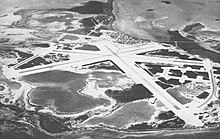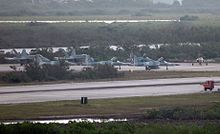Naval Air Station Key West
| Naval Air Station Key West | |||||||||||
|---|---|---|---|---|---|---|---|---|---|---|---|
Boca Chica Field | |||||||||||
| Near AMSL | |||||||||||
| |||||||||||
| Source: Federal Aviation Administration[1] | |||||||||||

Naval Air Station Key West (
NAS Key West is an
On a broader scale, NAS Key West's national security mission supports operational and readiness requirements for the
The air station is also host to several tenant commands, including
History
1823–1914
The U.S. Navy's presence in Key West dates back to 1823 when a Naval Base was established to stop
World War I
During
The nation's southernmost Naval Base proved to be an ideal year-round training facility with rapid access to the open sea lanes and ideal flying conditions for Naval Aviation. The Navy's forces were expanded to include
On 22 September of that year, the base's log book recorded the first naval flight ever made from Key West – a
Naval Air Base Key West pilots flew in search of
On 18 January 1918, the first class of student aviators arrived for seaplane training, which launched the station's reputation as a premier training site for
Interwar period
After World War I, the base was decommissioned and its personnel were transferred or released. Most of the buildings were destroyed or dismantled and moved to other locations. The remaining facilities were used only occasionally during 1920–1930 for seaplane training. The station remained inactive until 1939.
The seaplane base was designated as a Naval Air Station Key West on 15 December 1940 and served as an operating and training base for fleet aircraft squadrons, to include seaplane, land-based aircraft, carrier-based aircraft and lighter-than-air blimp squadrons. This set the stage for America's entry into World War II. The government had retained the property during the interwar period of the 1920s and 1930s, which proved to be a wise decision as the nation scrambled to re-arm in a state of emergency at the outbreak of the war.
World War II

Naval Base Key West was reopened just prior to the United States' entry into
By 1943,

Cold War
After World War II ended, NAS Key West was retained as a training facility. On 1 June 1962, the Navy AN/FPS-37 Radar site was added to the
NAS Key West was to become a focal point during the 1962 Cuban Missile Crisis, which posed the first doorstep threat to the United States in more than a century. Reconnaissance and operational flights were begun 22 October 1962, in support of the blockade around Cuba. During the Missile Crisis, Key West cemented its claim to the title "Gibraltar of the Gulf", coined over a hundred years earlier by Commodore David Porter.
By 1964, the USAF added an
In 1946,
In the 1970s,
In 1973, Reconnaissance Attack Wing 1 (RECONATKWING ONE) began relocation from the closing

Due to its superb flying weather, NAS Key West has also hosted several permanent detachments of the fighter and strike fighter Fleet Replacement Squadrons (FRS) at
The Atlantic Fleet

During the 1980s and 1990s,
Late Cold War / Post-Cold War / Present day
During the 1980s and into the mid-1990s, NAS Key West's Trumbo Point Annex and Truman Annex waterfront pier areas served as the home port for the Pegasus-class hydrofoils of Patrol Hydrofoil Missile Squadron TWO (PHMRON TWO).
In the late summer of 1994, NAS Key West also served as a primary staging base for Operations Support Democracy and
On 5 October 2001, Naval Air Station Key West was temporarily downgraded and redesignated as Naval Air Facility Key West, but on 1 April 2003, the air facility was upgraded and restored back to full air station status as Naval Air Station Key West.[9]
As in the past, NAS Key West continues to be frequently utilized for detachments by active and reserve U.S. Navy strike fighter squadrons and carrier airborne early warning squadrons,
Units conducting detachment training at NAS Key West utilize the Key West Complex airspace, a system of overwater Warning Areas to the south between the Florida Keys and the island of Cuba, to the west beyond the Dry Tortugas, and to the northwest over the Gulf of Mexico. Warning Area 174 (W-174), Warning Area 465 (W-465), the Key West OPAREA, and the Bonefish Air Traffic Control Assigned Airspace (ATCAA) define the Key West Complex airspace. The majority of the airspace is covered by a Tactical Aircrew Combat Training System (TACTS) range that continuously tracks aircraft positions and maneuvering parameters, recording everything for later playback during mission debrief.[10]
U.S. Navy
In 2019, a 20-year-old Chinese student received a year in prison for photographing the facility.[11]
Tenant commands
- Fighter Squadron Composite 111 (VFC-111) Sun Downers
- Strike Fighter Squadron 106 (VFA-106) Gladiators, Detachment Key West
- Joint Interagency Task Force South
- U.S. Army Special ForcesUnderwater Operations School (SFUWO)
- U.S. Coast GuardSector Key West
- Naval Air Warfare Center Aircraft Division (NAWCAD) Atlantic Targets and Marine Operations (ATMO) Detachment Key West
Facilities
NAS Key West's Boca Chica Field has three paved runways:
- Runway 08/26: 10,001 x 200 ft. (3,048 x 61 m), Surface: PEM
- Runway 04/22: 7,002 x 150 ft. (2,134 x 46 m), Surface: PEM
- Runway 14/32: 7,001 x 150 ft. (2,134 x 46 m), Surface: PEM
Auxiliary annexes
In addition to the main air station on Boca Chica Key, NAS Key West comprises several separate annexes in the Key West area. These additional properties include:
- Truman Annex (the former Naval Station Key West surface ship and submarine base until 1974)
- Trumbo Point Annex (the former NAS Key West seaplane base)
- Sigsbee Park Annex
- Naval Branch Health Clinic Key West (site of the former Naval Hospital Key West)
NAS Key West also holds responsibility for several other properties and activities in the Florida Keys. Most military family housing, as well as the Navy Exchange, Commissary, Navy Lodge guest billeting, RV park and other Morale, Welfare and Recreation (MWR) activities are located at Sigsbee Park, a man-made island on the north side of Key West created from dredging of seaplane runways for the NAS Key West seaplane base at Trumbo Point in the 1940s. Family housing is located at both Trumbo Point and the Truman Annex, while single enlisted service members are housed at the main installation at Boca Chica and on Truman Annex. Family housing is managed by Balfour Beatty Communities, a public-private venture (PPV) partner.
Also at Trumbo Point is the Navy Gateway Inns and Suites (NGIS), formerly known as the Bachelor Officers Quarters (BOQ) and later the Combined Bachelor Quarters (CBQ). NGIS accommodates transient government personnel and dependents. Distinguished Visitors (DV) quarters are also available for senior commissioned officers (O-6 through O-10). The CBQ is very visible from North Roosevelt Boulevard and Palm Avenue, with its "FLY NAVY" logo painted prominently on the south side of the building (it is the tallest building on the island of Key West). It is approximately a mile, or a twenty-five-minute walk, from the NGIS to Duval Street downtown.
Truman Annex is the remaining portion of the former Naval Station Key West that closed in 1974 that is still under military control. It has a beach and is the location of Headquarters,
Fleming Key is the site of the
Accidents and incidents
The following notable accidents and incidents have occurred at NAS Key West:
- April 25, 1951: bureau number 39939, on a practice instrument approach to NAS Key West. Both aircraft plunged into the sea; Navy personnel at the base witnessed the accident and immediately launched rescue and recovery efforts, but all 34 passengers and five crew aboard the DC-4 were killed, along with the pilot-instructor, two student pilots, and radio operator aboard the SNB. The accident occurred at midday, weather was clear with unlimited visibility, and both flights had been cleared to fly under visual flight rules, being expected to "see and avoid" other aircraft; the student flying the SNB was wearing view-limiting goggles, but the other SNB crew were not, and were expected to keep watch. Ground witnesses said that neither aircraft took evasive action prior to the collision, and the Civil Aeronautics Board attributed the accident to the failure of both flight crews to see and avoid conflicting air traffic.[14]
See also
References
- PDF
- ^ Ranter, Harro. "Key West NAS, FL profile - Aviation Safety Network". aviation-safety.net.
- PDF, effective 2007-10-25
- ^ "Cubic's Next Generation Air Combat Training System Now Operational at NAS Key West, Luke AFB > Cubic Corporation". www.cubic.com. Archived from the original on 2011-05-19.
- ^ "Naval Air Station Key West". cnic.navy.mil.
- ^ a b "65th Artillery History". Archived from the original on 2019-05-16. Retrieved 2019-05-16.
- ^ Key West Hawk Missile Site Map. Keyshistory.org. Retrieved on 2013-09-18.
- ^ Winkler, David F. (1997), Searching the skies: the legacy of the United States Cold War defense radar program. Prepared for United States Air Force Headquarters Air Combat Command.
- ^ "NAS Key West: Command History". Naval Air Station Key West (official site). Archived from the original on 2006-12-09. Retrieved 2006-12-10.
- ^ Pike, John. "Key West Complex". www.globalsecurity.org.
- ^ "Chinese student sentenced for photos of US Navy base - CNN Video". CNN.
- ^ "Key West Naval Air Station (Boca Chica Field)". Retrieved 2016-01-20.
- ^ "Naval Air Station Key West". GlobalSecurity.org. Retrieved 2006-12-10.
- ^ Investigation of Aircraft Accident: COMPANIA CUBANA DE AVIACION AND U.S. NAVY: KEY WEST, FLORIDA: 1951-04-25 (Report). Civil Aeronautics Board. October 22, 1951. F-104-51. Retrieved January 18, 2022.
External links
- Official website
- FAA Airport Diagram (PDF), effective April 18, 2024
- Resources for this U.S. military airport:
- FAA airport information for NQX
- AirNav airport information for KNQX
- ASN accident history for NQX
- NOAA/NWS latest weather observations
- SkyVector aeronautical chart for KNQX

